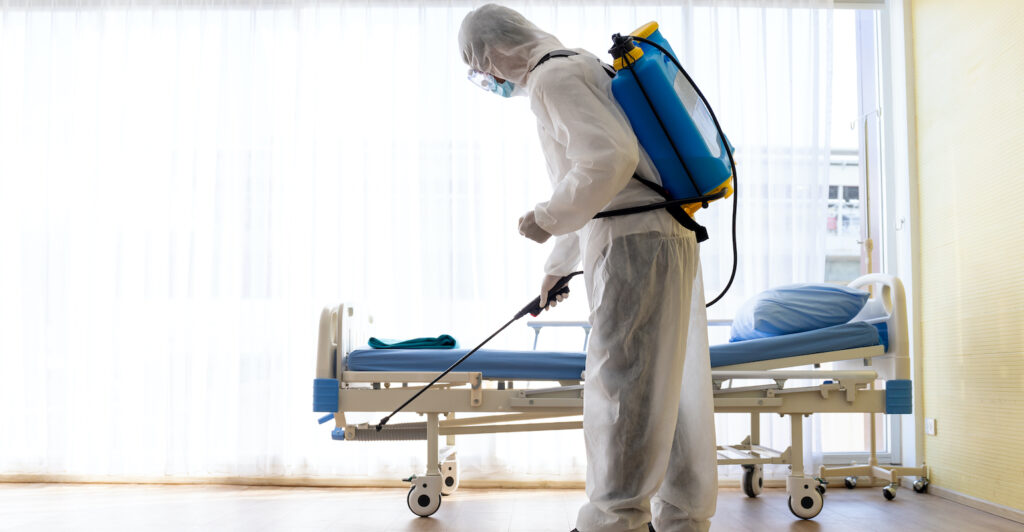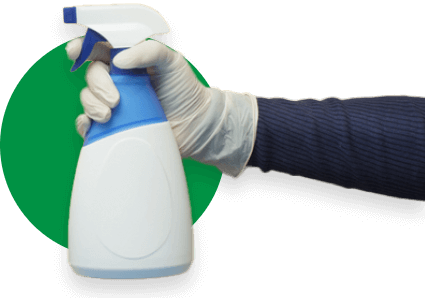Maintaining cleanliness in hospital patient rooms is vital for patient safety and infection control. It’s essential to know hospital patient room cleaning procedures because they play a critical role in ensuring patient room hygiene.
From daily cleaning checklists to the nuances of healthcare facility cleaning, each aspect contributes significantly to the overall maintenance of hospital rooms.
Understanding the intricacies of these procedures helps hospitals create safe, hygienic environments for patients and healthcare workers.
The Importance of Maintaining Patient Room Hygiene
Maintaining patient room hygiene is crucial for positive health outcomes in hospitals. Countless studies have reported that pathogens can survive on various surfaces in healthcare settings, including those at the patient bedside and patient bathrooms The most common surfaces are:
- Mattresses, linens, and pillows
- Bedframes and bedrails
- Toilets and soap dispensers
- Floors
Adherence to hospital patient room cleaning procedures directly impacts patient safety by significantly reducing the risk of healthcare-associated infections (HAIs). Therefore, a hospital patient’s room must be thoroughly cleaned, including regular disinfection and maintenance.

Framework of Hospital Patient Room Cleaning Procedures
The systematic approach to hospital patient room cleaning procedures is a cornerstone of maintaining a safe and hygienic healthcare environment. These procedures ensure excellent patient room hygiene and effective hospital room maintenance.
First, hospitals must assess the room to identify specific cleaning needs. Following this assessment, the cleaning staff adheres to a daily cleaning checklist designed for hospitals, which typically includes the following key steps:
- Visual Assessment: Check for cleaning challenges, obstacles, needed supplies, and damaged items during this step.
- Systematic Approach: Next, clean systematically, moving clockwise or left to right in multi-bed areas to ensure comprehensive coverage.
- Surface Cleaning: Disinfect all surfaces, especially high-touch areas like bed rails, doorknobs, and light switches.
- Clean Sequence: Prioritize cleaning less contaminated surfaces before more contaminated ones to minimize the spread of microorganisms.
- Top-to-Bottom Cleaning: Adopt a top-to-bottom cleaning approach to prevent contamination of already cleaned areas.
- Waste Disposal: Safely remove and dispose of all waste materials to minimize the risk of contamination.
- Floor Care: Sweep and mop the floors with hospital-grade disinfectants, ensuring the removal of pathogens.
How Long Does It Take to Clean Hospital Rooms?
Cleaning a hospital patient room efficiently is crucial in maintaining a sterile environment for patients. But, how long does it take to do it? The time can vary significantly based on several factors.
Hospital patient room cleaning procedures often range between 25 to 45 minutes per room. The complexity of hospital room maintenance, such as the size of the room and the level of disinfection required, also plays a role.
A daily cleaning checklist for hospitals ensures no surface goes unnoticed, contributing to a more systematic approach.

Cleaning Guidelines for Healthcare Facilities
Stringent industry standards govern healthcare facility cleaning to ensure patient safety and infection control.
Key Industry Standards
- Routine and Deep Cleaning: Regular cleaning schedules should align with the hospital patient room cleaning procedures, ensuring thoroughness in every aspect of hospital room maintenance.
- Disinfection Protocols: Healthcare facilities must place special emphasis on disinfection practices to reduce the risk of HAIs.
- Staff Training and Compliance: Continuous training in healthcare facility cleaning is crucial for staff to stay updated with the latest guidelines and protocols.
- Approved Cleaning Products: Use hospital-recommended products and adhere to manufacturer guidelines.
- Isolation Room Protocol: Enhance cleaning and waste disposal protocols in isolation rooms, especially after patient discharge.
- Equipment Cleaning: Following specific guidelines, clean and sterilize medical equipment after each use.
- Hand Hygiene: 80% of infections happen through hand contact, highlighting the clear need for good hand hygiene.
- PPE Usage: Wear appropriate personal protective equipment (PPE) during cleaning and dispose of it correctly.
Daily Cleaning Checklist for Hospital Rooms
A daily hospital room cleaning checklist involves various hospital patient room cleaning procedures. These steps include sanitizing surfaces for germ reduction and disinfecting areas exposed to bodily fluids, supplemented by high-dusting and eliminating bacteria from hard-to-reach places.
Key practices include thorough hand washing and glove usage, respecting patient privacy, and focusing on disinfecting high-touch areas. This includes spot cleaning of walls, floors, and countertops, sweeping, mopping, emptying trash, and sanitizing bedside areas. Similar principles apply to cleaning patient bathrooms, exam rooms, waiting areas, and cafeterias.

Elevate Your Medical Facility’s Hygiene with Our Expert Medical Cleaning Services
Maintaining top-notch cleanliness in medical facilities is essential, as we’ve covered above. Our comprehensive guide has emphasized the importance of hospital patient room cleaning procedures, the intricacies of healthcare facility cleaning, and the necessity of daily cleaning checklists for hospitals.
Facilities can plan and execute cleaning protocols effectively by understanding how long it takes to clean a hospital room.
Dallas Janitorial offers a specialized approach, ensuring every aspect of hygiene and maintenance is addressed with the highest level of expertise. Contact Dallas Janitorial today for a tailored medical cleaning solution that meets your facility’s unique needs.
Frequently Asked Questions
How do they clean hospital rooms?
Hospital patient room cleaning procedures are thorough and systematic.
They include dusting, surface disinfection, waste disposal, sanitization of high-touch areas, linen changes, and floor mopping with hospital-grade disinfectants to ensure optimal hospital room maintenance.
How do you clean an ICU room?
Start with strict infection control measures, followed by comprehensive surface disinfection. Terminal cleaning and meticulous equipment sterilization are essential, particularly after patient discharge.
Waste disposal and ensuring proper ventilation are key steps in maintaining ICU cleanliness. Open windows or use air systems in rooms with infectious patients, following CDC guidelines, to ensure nearly all (99.97%) Mycobacterium tuberculosis germs are removed.
What is routine cleaning in the hospital?
Routine cleaning in a hospital refers to daily cleaning tasks essential for maintaining a consistent level of hygiene. This includes surface disinfection, floor cleaning, and waste management.
What are the five steps in a cleaning procedure?
A typical cleaning procedure involves preparing surfaces by removing loose debris and dust, followed by washing with soap and water. The subsequent steps include rinsing off the soap, applying disinfectants to eliminate germs, and finally, drying surfaces to prevent bacterial growth.
What are the three major steps in cleaning?
The major steps in cleaning encompass cleaning with soap and water to remove dirt, disinfecting with chemicals to kill germs on surfaces, and sanitizing to reduce and prevent the spread of germs.
Usually, disinfectants with chlorine, having 500 to 5000 ppm of free chlorine (mixing 1 part of 5% chlorine bleach with either 100 or 10 parts of water, depending on how big the spill is), work well for cleaning up spills. But, it’s important not to use chlorine-based disinfectants for urine spills.


